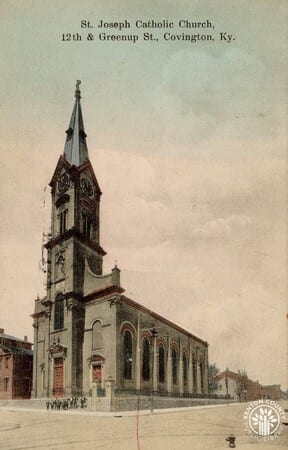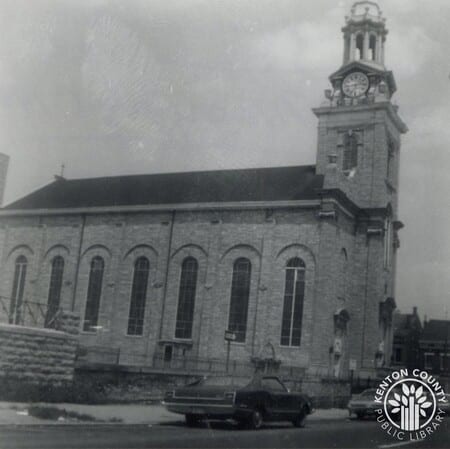Community History - Covington - Saint Joseph Church and School
The German Catholic population of Covington increased dramatically during the 1840s and 1850s. Father Ferdinand Kuhr, Pastor of Mother of God Parish, organized the German Catholics living in the southeast section of the city in the Helentown Neighborhood into a separate congregation in 1853. A lot was purchased a lot (125′ x 178′) the northwest corner of E 12th and Greenup Streets in November 1853. Eighty families formed the nucleus of the new congregation which was placed under the patronage of St. Joseph.
In the summer of 1854, construction began on the new St. Joseph Church. A lack of finances, however, resulted in only the completion of the foundations. Instead, it was decided to postpone the construction of the church and to turn their attention to the construction of a combination church and school building. This combination building was dedicated in 1855. Initially, St. Joseph Parish was cared for by diocesan priests and priests from Cincinnati religious orders. In 1858, Covington Bishop George A. Carrell arranged for the Benedictine Priests of Latrobe, Pennsylvania to establish a priory in Covington and to care for the new St. Joseph Parish. The first Benedictines to minister in Covington were Fathers Oswald Mossmueller and Romanus Hell.
St. Joseph School 1892 Graduates
Under the direction of the Benedictines, the people of St. Joseph began work on the completion of their permanent church which had been begun in 1854. The church was designed by the architectural firm of Anthony Picket and Sons of Cincinnati and measured 136′ in length and 66.8′ in width. Bishop Carrell blessed the new edifice in August 1859. The total cost on construction reached the amount of $18,000.
The Benedictine priests living at St. Joseph Priory were also responsible for a large mission territory in Northern Kentucky. They attended missions and stations at John’s Hill, Mullin’s Station, Ashland, Augusta, Florence, Foster’s Landing, Morning View and Brooksville in Kentucky as well as a station at Ripley, Ohio.
In 1862, Father Odilo von der Green O.S.B. was appointed Pastor of St. Joseph Church. Father von der Green recognized the need for suitable church furnishings and ornamentation in the United States. With this in mind, he established the Institute of Catholic Art at St. Joseph Parish in Covington. The institute was staffed by several Benedictine Brothers, including Brother Cosmas Wolf and many notable layman including Johann Schmidt and Frank Duveneck. Many of these talented artists had studied at the Royal Academy of Art in Munich, Bavaria. The aim of the institute was to produce beautiful and artistic altarpieces, other ecclesiastical furnishings and murals for Catholic churches in the United States. The institute’s workshop was located behind St. Joseph Church on Bush Street in a small frame building. The institute proved very successful, and produced furnishings and murals for churches and convents throughout the American Midwest. Among their works were the magnificent high (40′ tall) and side altars at St. Joseph in Covington. The institute remained in Covington for about ten years before moving to the Benedictine Monastery ion Latrobe, Pennsylvania in c. 1872.
The Benedictine Sisters arrived in Covington from Erie, Pennsylvania in 1859 to care for the children at St. Joseph Girls School. The boys were initially taught by a layman. A new boys school was built on E 12th Street, between Greenup and Garrard Streets, in 1870. In 1885, the Brothers of Mary of Dayton, Ohio were engaged to teach at St. Joseph Boys Schools. The brothers also opened St. Joseph High School for boys. The high school offered a two-year commercial curriculum for the young Catholic men of Northern Kentucky. N 1925, St. Joseph High School closed. It was replaced by the new Covington Catholic Central High School which was located at Mother of God School on W. 6th Street.
In 1863, the congregation purchased two large bells for the church tower. The larger of the two (2,200 lbs) was named St. Maria and the smaller (1,600) was named St. Joseph. A new steeple, the tallest in the City of Covington, was built by the congregation in 1877. The steeple reached 305′ into the sky. A new 650 lbs bell was added to the tower during that same year.
In 1879, Father Aegidius Christoph O.S.B. was transferred from Chicago to St. Joseph Church in Covington. Under Father Aegidius guidance, the debt on the church was greatly reduced and a new daughter parish was established in the Austinburg neighborhood of Covington. Father Aegidius was instrumental in the selection of a lot on E. 16th Street and for the construction of the first St. Benedict Church. Father Aegidius died on March 27, 1887. At first he was laid to rest at Old Mother of God Cemetery. However, his body was later disinterred at the request of the parishioners and placed in a specially designed vault beneath the floor of St. Joseph Church.
In anticipation of the parish golden jubilee, a thorough remodeling of the church building took place. The sanctuary floor was tiled, a new marble Communion rail purchased, new Stations of the Cross were acquired and new stone entry steps were constructed. St. Joseph was solemnly consecrated on July 16, 1905. That same evening, a class of 100 was confirmed by Bishop Camillus P. Maes.
The church building was further enhanced with the installation of ten new stained glass windows in 1910. The windows were supplied by the firm of Morgan and Sons of New York City. The windows on the Epistle side depicted scenes from the life of St. Benedict and those on the Gospel side depicted scenes from the life of the Holy Family. The total costs of the windows reached the sum of $8,075.
On the evening of July 7, 1915, a tornado swept through Northern Kentucky, damaging many churches and other structures. The high winds completely destroyed the upper portion of the St. Joseph Church steeple. The steeple crashed through the façade of a home at the corner of 12th and Greenup Streets. The architectural firm of Hannaford and Sons was commissioned to design a new tower for the church. The design called for a new tower surmounted by an elegant cupola.The work was completed in 1916. The clock tower was supplied by the Howard Clock Co. of Boston, Massachusetts. In 1918, membership at St. Joseph consisted of 420 families with a school enrollment of 378 taught by five Sisters of St. Benedict and four Brothers of Mary.
St. Joseph parishioners set a goal of a new school building for the post World War I era. Property was acquired at the northeast corner of 12th and Scott Streets adjacent to St. Walburg Academy as the site for the new school. In 1927, the architectural form of Kunz and Beck of Cincinnati was given the commission to design a modern building with twelve classrooms to replace the old boys and girls school buildings. The new brick school was officially blessed on July 29, 1928. The old boys school became a residence for the Brothers of Mary and the old girls school was demolished. The parish celebrated its diamond jubilee in 1934 with a grand Mass. At that time, the congregation maintained a membership of nearly 2,000.
In the years following World War II, St. Joseph Parish began a general decline. By 1953, school enrollment had declined to 157. The Helentown neighborhood was becoming a less desirable neighborhood, and many parishioners began the exodus to the suburbs. Despite declining membership, the parish continued to make improvements on their buildings. In 1951, a perma-stone covering was placed on the exterior walls of the church. Two years later, the interior of the church was re-frescoed and all the statuary restored. These improvements were made in anticipation of the centennial of the parish which was celebrated in 1955.
During the 1960s, membership at St. Joseph began a dramatic decline. In 1967, the parish school was merged with the nearby Cathedral School to form Bishop Howard Elementary. The new Bishop Howard School was located in the former St. Joseph School building at E12th Street and Scott Blvd.
In 1970, Bishop Richard H. Ackerman announced the closing of St. Joseph Parish. By this time, membership had declined to 150 families. The last Mass was celebrated in the old Church on July 5, 1970. The church building, including its two large murals by noted Covington painter Johann Schmitt and three large had-carved altar, was demolished in the fall of 1970. The body of Father Aegidius Christoph O.S.B. was removed from its crypt in St. Joseph Church and returned to St. Vincent Archabbey in Latrobe, Pennsylvania.
St. Joseph’s Church, Covington, Kentucky 1855-1970; Historic Sketch of St. Joseph Church, Covington, Kentucky 1935; Annemarie Springer, Nineteenth Century German-American Church Artists (2001); Kentucky Post, March 7, 1916, p. 1, August 24, 1970 and October 5, 1970; Kentucky Enquirer, July 2, 1970; Dailey Commonwealth, October 28, 1877, p. 4 and November 5, 1877, p. 4


